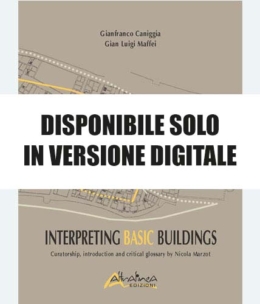Architectural Composition
and Building Typology
This series of four manuals moves from the conviction that the crisis affecting the building and architectural sector is connected with the buildings’ formal hyperindividuality, having its roots in the designers’ solipsistic élan (valuing art over functionality) and the client’s self-congratulatory approach. Consequently, our cities tend to resemble alienating graveyards, scattered with hardly-interrelated cenotaphs. Since 1979, with the collaboration of prof. Gianfranco Caniggia, we have been trying to develop a method to overcome this crisis, investigating its historical reasons and performing a critical analysis of the typological consistency of buildings in the various cultural areas. Observation of existing structures has thus revealed an architectural and building approach based on the comparison of contemporary and older products. Furthermore, a careful study of the buildings’ evolution and organic mutations shows a constant modification of the building heritage capable of “legitimating” the city’s future architectural development. The choice to split the work into four volumes is only a functional one, and the result of a design teaching method that has been adopted for decades in Architecture Faculties at universities in Italy and all over the world.
Plan of the series:
1. G. Caniggia, G.L. Maffei, Interpreting basic buildings;
2. G.L. Maffei, M. Maffei, Interpreting specialised buildings (in press)
3. G. Caniggia, G.L. Maffei, M. Maffei, N. Marzot, Basic buildings design (in execution)
4. G.L. Maffei, M. Maffei, N. Marzot, Specialised buildings design (in execution)

Interpreting specialised buildings
M. Maffei

Interpreting basic buildings
G.L. Maffei





